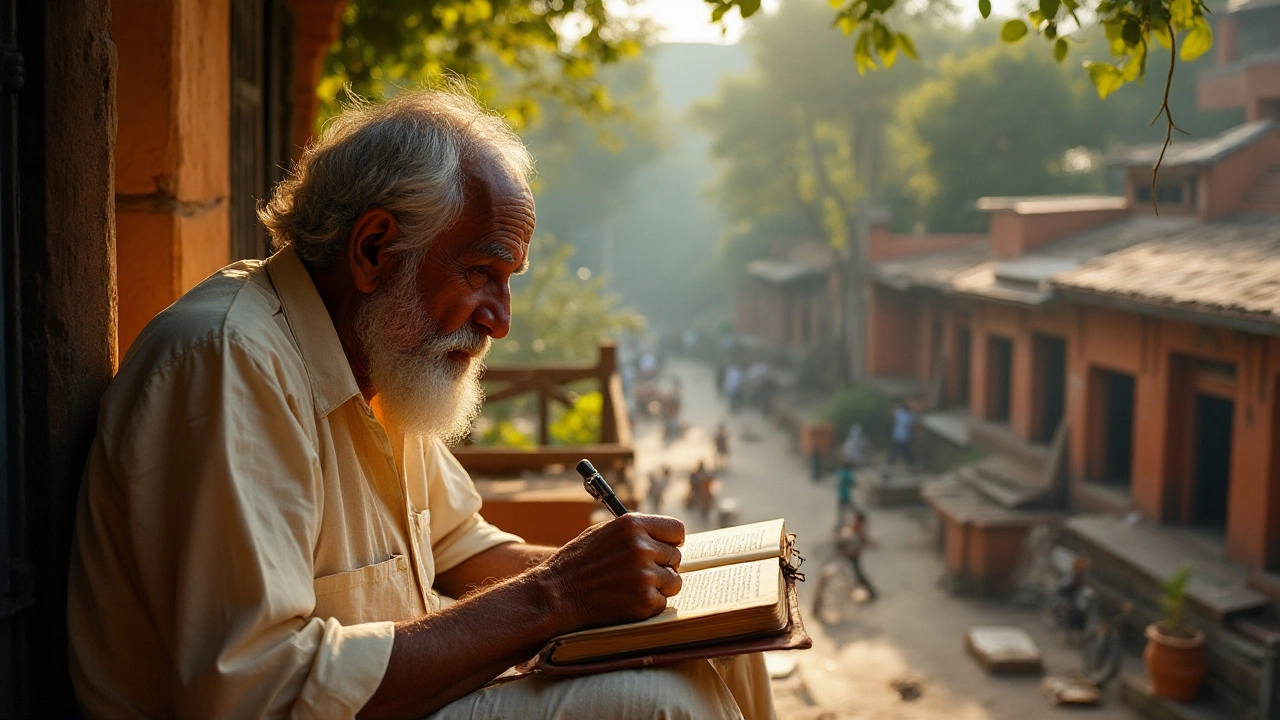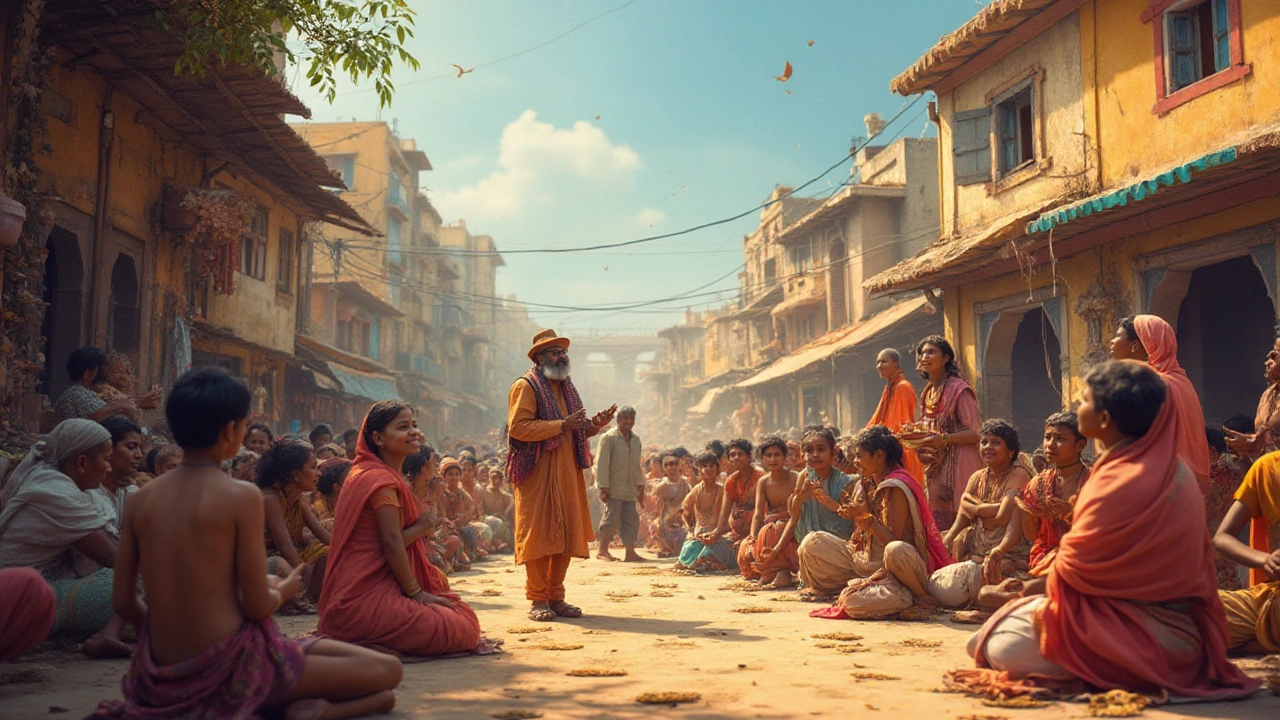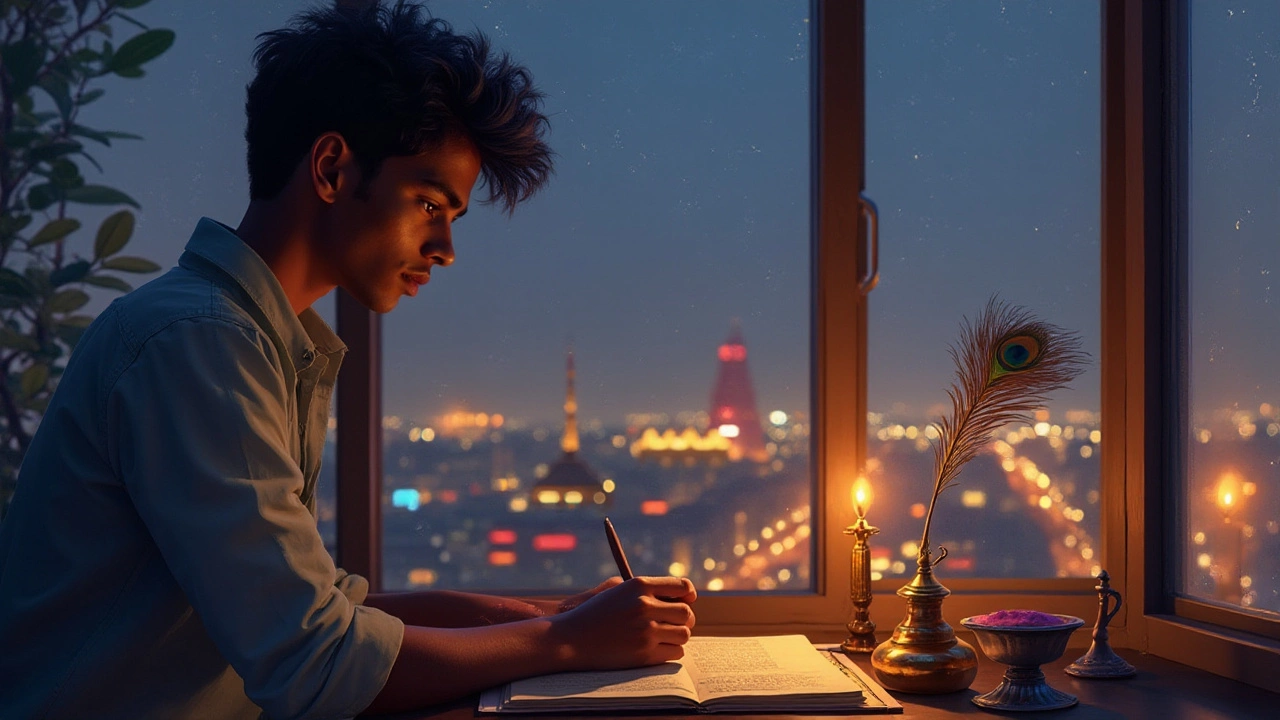Exploring Nostalgic Poetry: Capturing the Essence of Indian Memories

Nostalgic poetry stands as a fascinating literary realm where the essence of past experiences is artfully woven into words. When we peruse such poems, it's akin to flipping through old, cherished photographs, each verse resonating with emotions that have long nestled in the heart. In the rich tapestry of Indian literature, nostalgic poetry carries profound cultural and personal significance, painting vivid pictures of bygone eras and evoking collective memories.
This exploration will dive into how nostalgic poetry is defined and its pivotal role within the Indian context, characterized by its rich history and diverse heritage. Readers will gain insight into how emotions and themes are delicately balanced to create an immersive experience. For aspiring poets, the article will offer practical advice on capturing this elusive essence in their writing, ensuring their nostalgic reflections remain authentic and deeply relatable.
- Understanding Nostalgia in Poetry
- Historical Significance in Indian Context
- Themes and Emotions in Nostalgic Poems
- Writing Tips for Aspiring Poets
- Impact of Nostalgic Poetry on Readers
Understanding Nostalgia in Poetry
Nostalgia in poetry is like unlocking an emotional vault—each poem serves as a key that opens a world of feelings and memories preserved through language. As a literary device, nostalgia transports us back in time, allowing those old moments to come alive once more. It's not merely about reminiscence; it's an emotional longing for something that is lost but cherished, a poignant mix of happiness and sadness. In poetry, nostalgic poetry evokes this bittersweet sensation, inviting readers to a shared experience while unraveling the tapestry of their personal past.
The role of nostalgia in Indian poetry is particularly significant, as it explores themes from ancient texts to contemporary verses. India, with its deep cultural heritage and complex history, offers a vast source of nostalgia that poets tap into. From Rabindranath Tagore's lyrical expressions reflecting the rural beauty and spiritual depth of Bengal to the modern poets echoing the hustle of city life blended with remnants of traditions, the spectrum is vast and vibrant. This cultural diversity adds layers of nostalgia, making each poem a journey through time and tradition, offering a window into the past with resonant lines.
Understanding nostalgia means acknowledging not just what the poets yearn for but how they craft their verse to evoke this longing. Many poets focus on the sensory details that vividly bring back the past—a whiff of incense, the sound of temple bells, or the sight of monsoon rains splattering on ancient city stones. These sensory connections are crucial in creating the atmosphere of nostalgia. Consider the powerful imagery in poems like those of R. Parthasarathy who in his work “Rough Passage” reflects the longing for roots amidst modern-day displacements.
"Poetry is the spontaneous overflow of powerful feelings: it takes its origin from emotion recollected in tranquility." — William Wordsworth
Creating nostalgia in poetry often involves tapping into universal themes like childhood, lost love, or transformation which strikes a chord with many. This is the essence of Indian poetry—it resides in the shared heritage of its people. Writing such poetry involves not only depicting the past but also reevaluating it with a contemporary lens, making connections between what was and what is now, thus offering a bridge between eras. This act of bridging fills the prose with layers that readers can peel back, examining their connections with their own lives.
For those aspiring to construct their own narratives imbued with nostalgia, it is essential to be genuine and emotionally truthful. Drawing on personal memories can lend authenticity to their words, making poems relatable. Engaging with sources of emotional significance in their lives allows poets to craft verses that truly resonate, stirring both individual and collective memories and embedding them in the universal human experience.
Historical Significance in Indian Context
Nostalgic poetry in India weaves a rich tapestry, intimately connecting the past with the present. This literary form is steeped in the dynamic and diverse cultural heritage of the nation, offering readers a glimpse into historical eras and the everyday lives of people from different epochs. During India's classical era, for instance, poets like Kalidasa brilliantly captured the beauty and ethos of their times. Later, with the advent of the Bhakti movement, poetry began reflecting personal and spiritual quests, infused with cultural ethos and devotional fervor. These poets often used nostalgia as a way to evoke spiritual truths cloaked in the simplicity of past memories and conventional society.
In the colonial period, nostalgic poetry took on a new dimension, both as a refuge and a means of subtle resistance against foreign dominion. Poets like Rabindranath Tagore infused their works with an innate longing for reclaiming cultural identity amidst the changing landscape. Tagore, for instance, through works like 'Gitanjali', evoked a sense of longing and devotion, balancing the traditional with a forward-thinking vision for India. Nostalgia became a tool for engaging readers with a powerful mix of personal reflection and national identity.
"Let my country awake" — this famous line from Tagore encapsulates the yearning for a renaissance of cultural memory and strength.
As India transitioned into independence, the nostalgic gaze embraced both the triumphs and trials of creating a new identity. Modern poets like P. Lal and Kamala Das continued exploring the theme by turning inward, reflecting personal and national narratives while staying rooted in memory. The development of nostalgic themes mirrored the complexities of a modernizing society bearing the weight of its ancient roots; thus, nostalgic poetry became a nuanced, ever-evolving conversation between past and present. It's fascinating, too, how the rural-urban divide of post-independence India found its voice through verses that longed for the simplicity of pastoral life, even as they celebrated the burgeoning urban landscapes.
Today, nostalgic poetry in India resonates deeply as it continues to remind contemporary society of the timeless beauty and lessons embedded in its historical milestones. It invites readers to step into the shoes of generations past, appreciating their stories and sacrifices. This journey through memory establishes a bridge between cultures, allowing new generations to comprehend their heritage through the lens of poetic imagery. The charm lies in its power to evoke emotions that are intensely familiar yet freshly introspective.

Themes and Emotions in Nostalgic Poems
Nostalgic poetry is a rich tapestry of emotions, intricately woven with themes that tug at the strings of memory and echo the rhythm of cultural heritage. At the heart of these poems, nostalgia is an emotion that transcends time, allowing both poets and readers to relive moments that have shaped their identities. In India, with its centuries-old traditions and stories, nostalgic poetry can explore themes like the innocence of childhood, the fragrance of monsoon rains, and the warmth of familial bonds. Such themes are not only universal in their appeal but embedded deeply in the collective consciousness of societies.
Take, for instance, the common theme of longing for a bygone era. This longing isn't just about missing what was; it's a deeper yearning for the simplicity, the beauty, and sometimes the idealism associated with the past. Nostalgic poems tap into this sentiment by painting vivid pictures of village life, grandparent's tales, and festivals that spark joy despite changing times. These spiritual and physical connections to the past are essential for the emotional intensity of the work. When poets capture this essence, the reader is transported, as if flipping through an old diary where each entry resonates and rekindles emotions thought to be long forgotten.
One cannot ignore the influence of cultural memories in Indian nostalgic poetry. Celebrated poets have skillfully integrated these themes, crafting verses that echo across generations. A notable quote by Rabindranath Tagore perfectly encapsulates this, "The butterfly counts not months but moments, and has time enough." This line isn't merely about a butterfly but beautifully captures the fleeting nature of precious memories. The essence of such poetry often lies in its ability to contextualize emotions and bring a sense of peace and happiness with the acknowledgment of time's passage.
Nostalgic poems often employ a potent mix of joy and melancholy, offering a bittersweet taste that isn't easy to forget. This duality lies in the comfort of familiar feelings against the inevitable passage of time. These works dive into the layers of familial love, lost traditions, and homes left behind. It also presents an opportunity for poets to examine personal growth through the lens of history and experiences. A common theme is the journey of migration and the subsequent longing for one's roots. In modern times, when global mobility is the norm, this universal experience finds a poignant reflection in poetry.
To craft nostalgic poetry, one should blend these themes seamlessly with evocative language that can stir emotions. Poets might focus on the sensory details – the smell of earth after rain, the sight of fields swaying with the wind, or the sound of bustling markets. These sensory evocations help ground the work in reality, allowing readers to relate their experiences with the textual images. Aspiring poets should aim to connect these elements, forming a bridge between past memories and present emotions that resonate long after the stanza ends.
Writing Tips for Aspiring Poets
Crafting nostalgic poetry can feel like an inviting call to the heart’s wellspring of memories, where the past gets woven into the fabric of words. To create poetry that truly resonates, one should start by immersing themselves in their personal history. Begin by reflecting on distinct moments that were pivotal or especially moving in your own life. Often, the small, seemingly insignificant experiences hold the most universal truths. Engaging deeply with these memories can yield a rich tapestry from which to draw poetic inspiration, transforming an ordinary reflection into a lyrical masterpiece.
Another aspect to consider is the sensory detail in your work. Vivid images and descriptions are what anchor a reader in the world of the poem, inviting them to not just read, but to feel and experience it as a direct participant. Use language that appeals to the senses—sight, sound, touch, taste, and smell—to build a fuller, more evocative scene. When the scent of a childhood dish or the distant sound of a lullaby echoes through your verse, it captures the reader's imagination and transports them directly into that time and place.
To add depth to your poems, explore themes that transcend individual experiences and speak to universal emotions. Love, loss, joy, and longing are themes that reverberate through the canon of Indian poetry, capturing the human condition with a poignant clarity. Seek inspiration from seasoned poets; for example, Rabindranath Tagore’s work often encompasses this universality, drawing on particulars while reaching for the sublime. As you write, remain mindful of how these shared experiences might resonate with your audience, fostering a connection that is both intimate and expansive.
"We may be past the golden age of pure vocal activity in poetry, but we have not lost our longing for the music of words," observed noted critic Helen Vendler, underscoring the perpetual allure of sound rhythms in poetry.
Moreover, practice the art of brevity without sacrificing depth. Strive to make each word count, choosing language that is concise, yet rich in implications. This often involves revisiting your drafts with a critical eye, refining them until only the essence remains. Consider experimenting with different poetic forms that lend themselves to nostalgic themes, such as villanelles or sonnets, where the strict structures can help distill and enhance emotion.
Collaboration and Feedback
Bear in mind that writing is not an isolated endeavor. Sharing your work with others, be it poetry circles or through platforms like writing workshops, can be invaluable. Constructive feedback from peers not only helps refine your craft but also gives you fresh insights into how your poems are perceived. Engage actively with the cultural memories of others; often, their stories and perspectives can add layers of richness to your own writing journey. This sense of community often echoes the communal storytelling traditions of India, creating a tapestry of shared poetic expression.
Finally, as you hone your voice, allow yourself the freedom to explore. Don’t shy away from experimenting with poems that might initially seem outside your comfort zone. Sometimes the most profound creative discoveries come from unexpected places. Writing emotional verse requires bravery in vulnerability, a willingness to express personal truths that might resonate on far broader planes than anticipated. Legacy and literature are more than words on a page; they are profound echoes across time, urging poets to keep penning their memories, no matter the challenges.

Impact of Nostalgic Poetry on Readers
Nostalgic poetry has a unique way of resonating with readers, often weaving a tapestry of emotions that span across time. This kind of poetry has a profound ability to transport us back to meaningful moments, sparking a myriad of emotions. For many, it serves as a gentle reminder of what's been lost and cherished, forming a bridge that connects the past with the present. When readers encounter verses full of nostalgia, they often find themselves reflecting on their own experiences, bringing about a sense of introspection that is both healing and enlightening.
One fascinating aspect of Indian poetry filled with nostalgia is its ability to evoke cultural memories and traditions. Poems that artistically reminisce about ancestral lands, age-old traditions, or childhood memories often resonate profoundly with readers who share those experiences. Such poetry helps to reinforce cultural identity and provides a sense of belonging, especially for those living away from their homeland. In many ways, nostalgic poems allow individuals to immortalize fleeting moments that define personal and cultural narratives.
Beyond personal reflection, nostalgic poetry often encourages readers to think critically about the passage of time and how it shapes human experience. This kind of poetry has been noted for its capacity to influence emotional well-being, often bringing comfort to those grappling with change or loss. By revisiting past moments clad in poetic imagery, readers gain perspective, which can prove to be a powerful tool for emotional resolution. The fusion of memory and emotion in such works can evoke pathos, but equally, it can prompt joy and laughter when recalling lighter moments.
Poets like Rabindranath Tagore have masterfully captured nostalgia in their work, impacting readers globally. Tagore, through his eloquent verses, stirred sentimental reflections, and commented on the transient nature of life, showing that nostalgic poetry is not only about longing but also about appreciating the beauty of existence.
"The butterfly counts not months but moments, and has time enough," wrote Tagore, highlighting the importance of cherishing time, a recurring theme in nostalgic expressions.
The reach and impact of nostalgic poetry is also notable in how it influences conversations about societal values. Through the lens of personal reflection and collective historical memories, such poetry can invoke discussions around cultural preservation and identity. It serves an educational role, inspiring younger generations to value their heritage while also challenging them to envision a future where these traditions can evolve. In a more connected digital world, nostalgic poetry often sees a resurgence because of its role in maintaining a tangible connection to the past, something not easily achievable through modern minimalist forms of communication.
In summary, nostalgic poetry offers readers a reflective mirror, portraying the beauty of past experiences in lyrical form. Its ability to stir emotion, provoke thought, and preserve culture underscores its enduring power. The impact on readers is substantial, offering a space for contemplation and a deepening of personal and cultural awareness. Through nostalgia, the past remains an ever-present companion in the pages of poetry, bridging generations and timelessly celebrating the human spirit.